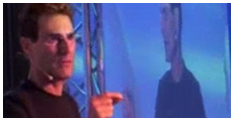Chapter 22
Paranormal optical phenomena
Paranormal optical phenomena are at once the most immediately appealing and the most elusive of all physical effects that we call ‘paranormal’ that is, apparently brought about by the proximity of humans, and contrary to the known laws of physical science. Visual perception gives information to the brain at the fastest rate of any of the senses, but the complicated transformation process along the way can give rise to numerous distortions of physical reality after-images, chromatic distortion, and so on. It is also common to some people to receive ‘clear’ mental quasi-visual images of people, objects, happenings, both in dreams and in other states of consciousness, some of them very close to full consciousness. The mind-brain mechanism of reception of such hallucinatory images is largely unknown territory, and the possibility of exploring it through the reports of psychic subjects is an exciting one.
The especially confusing feature is that hallucinatory and physical-origin images are sometimes inextricably mixed in the brain or mind. When a psychic says that he sees an ‘aura’ around a person’s head, or a parrot perching on his shoulder, it does not follow that either is a physical thing to which instruments such as cameras or photomultipliers would respond. This does not make them any less real to the psychic, nor does it prevent the psychic from seeing the person himself, and his physical surroundings, at the same time. Thus there is an inextricable mixture. We are led to hypothesise. ‘There are two sorts of parrot, physical and hallucinatory.’
And there is a further complication. Apparently genuine photographs exist of scenes which were only imagined as images by the psychic who took the photograph; the scenes were not observed by the witnesses. These are sometimes known as ‘thought-photographs’, and we shall return to them later in this chapter. So it may be possible to transmit visual information of non-physical origin not only to the eye-brain-mind system, but also to cameras and to other physical detectors of electromagnetic waves. We could possibly extend our hypothesis as follows: ‘and there are two sorts of origin of the photographic image.’
I have coined the phrase ‘quasi-physical’ phenomena to cover channels of perception which behave as though they originated with physical phenomena but which actually do not do so. The mind-brain system is capable of functioning as a mixer, which superposes physical and mental phenomena. Both physical and quasi-physical phenomena claim our attention in this chapter.
The most common report I hear is that the metal-bender has been ‘seeing lights’: a glow or a ball of light, usually orange or white in colour. Sometimes the light is near by, sometimes it is distant; sometimes it is described as a UFO sighting, and sometimes it is visible to more than one person. In the case of Willie G., a white light was usually seen by him at moments of strong metal-bending ‘power’; he claimed to have some control over its appearance and disappearance. At first I thought that all Willie’s light was quasi-physical, but this belief was shaken when two reliable observers, watching him from a distance when he thought he was alone, reported seeing lights above his head. Moreover Willie began to obtain curious photographs when using a Polaroid black and white instant camera at moments of light-seeing. Each shows a single smooth sphere illuminated both from the front and from behind. The conditions of Willie’s camera operation were controlled not by me but by Dr Cantor,(20) who insists that the Polaroid camera used was functioning correctly on the immediately preceding and immediately following pictures. I did control the conditions under which the photograph in Plate 22.1 was taken, which were within a light-sealed darkroom, using a new Polaroid camera provided by me and the centre section of a freshly purchased film pack; a run of previously black prints had been made with this arrangement immediately beforehand. Willie attempted to concentrate, and produced the curious textured image shown in Plate 22.1. It is true that chemical and electrostatic effects can produce gray fogging and also small patches of light on Polaroid film; but I believe that Willie’s textured picture of (possibly) human skin is not to be explained thus.
Willie is convinced that he has seen auras of light around some humans, and especially around himself when looking into a mirror. Sometimes he has claimed to see his own ‘chakras’, flower-like light sources from within the body; ‘chakras’ are well known in Indian mysticism (Kundalini yoga).(64) What Willie sees is not physical light, however, since in a darkroom neither my own vision nor a photomultiplier received any signal, even though Willie was claiming to see his aura. It does not appear that Willie’s auras are merely after-images, as is often supposed; but they do seem to be mental rather than physical phenomena.
Although I regarded the aura as mental ‘quasi-light’. I thought it might be worthwhile examining its ‘quasi-spectrum’: so I trained Willie to hold a diffraction grating up to his eye and describe in detail the colours he obtained with sources of physical light. He gave careful and repeatable descriptions of both continuum and line spectra, and when he looked at his mirror aura and forehead chakra in the same way, he described to me a continuum spectrum. On the supposition that there might be a contribution from real background light diffracted by something around his head, I varied the background light, using instead of white light, sodium yellow and mercury/cadmium with a green filter. But Willie insisted that what he saw through the diffraction grating remained a continuum, even though the relative brightness of the colours was changed.
Plate 22.1 Polaroid photograph taken by Willie G in light-tight room, with camera pointing towards him at a few inches’ distance. The small light spots may be chemical (or paranormal chemical) in origin, but it is difficult to explain the well-focused textured effect. Perhaps it represents a forehead in partial shadow.
I also asked Willie to vary the speed of a background stroboscopic light source until the rotation of one of his own chakras, seen in a mirror, appeared to cease. He was able to produce repeatable speeds, which for a 6-petalled chakra work out at a rotation of 7.5 revs/sec. Since it appears very likely that the visions are not of physical visible electro-magnetic radiation but are mental effects which we have termed ‘quasi-light’, these physical experiments are conceptually meaningless. But Charles Darwin used to describe ‘fool’s experiments’ which he sometimes deliberately conducted; he is supposed to have played the trombone to a group of climbing plants; I am proud to be in his company.
The phenomenon of ‘thought-photography’, in which photographic images are produced by paranormal means on light-sensitive film in a sealed camera, has claimed attention during the last few years. An English medium by the name of Hope produced paranormal photographic images more than fifty years ago, and was investigated by Crookes and other well-qualified investigators.(65) The best-known example of a ‘thought-photographer’ is the American Ted Serios, whose efforts have been described in detail by Dr Eisenbud.(66) Serios’s thought-photographs have included recognizable pictures of buildings and people, blurred and usually curiously distorted. A record of stills from a movie-camera exists in which the image can be seen to form and focus from one frame to the next. Serios’s work is sometimes regarded with suspicion because he insists on having a small black box (which he calls a ‘gismo’) in front of the camera, but always this box is found to be empty and incapable of playing a physical role. Serios has never been a professional entertainer, and the circumstances surrounding the phenomena he produces are difficult to dismiss as fraudulent.
Another modern subject, Willie Schwanholz, investigated by Professor Uphoff,(67) has the habit of moving his head during the ‘taking’ of thought-photographs. The instant camera covered with its lens-cap is pointed at his forehead, as is usual in thought-photography; but multiple images are found on the print, just as though a rapid series of mental images was projected.
Since a great deal of normal photography is produced in the darkroom rather than in the camera, suspicion has always accompanied the historical claims of the appearance of spirits and other things on photographs (the so-called ‘skotography’). The instant development technique developed by Dr Land and marketed under the name ‘Polaroid’ has therefore contributed greatly to easing the difficult task of the psychic investigator – to establish the genuineness of the thought-photograph phenomenon.
We can at present rely on the unspoiled character of a freshly purchased instant development film pack; we ensure that the camera is light-tight before we load it, and we can witness that the subject does not tamper with the loaded camera. In particular no pinhole must be allowed anywhere, since a pinhole camera image of the surroundings would ensue. It is my own practice not only to keep the shutter closed but to cover the front with a lens-cap and black tape as a double precaution. After concentration by the psychic, we withdraw the print and observe its instant development. Previously we have withdrawn one or two prints and ensured that they are perfectly black.
Camera cases are opaque to ultraviolet and infrared radiation, but they are transparent to X-rays and gamma-rays. They also possess orifices through which optical fibres could be inserted. We need to preserve security against these possibilities, and also against the methods by which a freshly purchased film pack can be opened up and exposed to optical images. This trick must be carried out in total darkness, by exposing the films in turn to some image source such as a transparency viewer. Signs of tampering can nearly always be detected in the subsequent examination of the film-pack contents, as will be seen from the following details.
The films in an instant pack are (at present) attached at one corner by a black metal staple of fairly precise dimensions. But since each film is required to be pulled out individually without disturbing its neighbours, the staple is divided from the rest of the plate by a continuous corner cut which extends from one edge of the film to the neighbouring edge, and leaves uncut only a gap of about l mm. It is this small section of the film-holding material that is broken when a film is pulled out for instant development.
To separate one film from the next, therefore, either the staple must be removed and subsequently replaced, or the film must be folded at the small piece of material which forms the gap in the corner cut. Both these methods leave signs of tampering, either a scratched or substituted staple, or creasing at the fold. It would indeed be difficult to avoid such signs, especially since the operation must be carried out in total darkness. Moreover, if each film is not replaced so that it precisely covers the next, and is not shadowed at the edge by the metal holder, a dark line will appear at one edge of the print. (One of those present at the Masuaki Kiyota session in London, Mr Hutchinson, has claimed to have found a method by which the pack can be exposed without signs of tampering being left, but this claim has not yet been fully investigated. If investigations are to be carried out using the difficult ‘homework’ technique, further security precautions with the pack would be advisable for example with French chalk, or fingerprint examination.)
Plate 22.2 Thought-photograph of London scene (possibly Trafalgar Square, although the details are not correct) produced by Masuaki Kiyota, but not under good observation
Plate 22.3 Thought-photograph of marching guardsmen (?) produced by Masuaki Kiyota, but not under good observation
Figure 22.1 Time-dependence of light Intensity I measured within camera during thought-photograph produced by Masuaki Kiyota.
I have described these signs of tampering in detail because they were searched for and not found when, in London, the instant photography expert examined the work of Masuaki Kiyota, whose thought-photography came to the notice of British television in 1978. Masuaki did not succeed in producing an image ‘to order’ in the television protocol, but he was able to produce images (shown in Plates 22.2 and 22.3) when the loaded camera was left with him for a period of hours. Naturally this was not accepted as watertight evidence, but with unnecessary lack of sympathy the trick of producing images on film pack was then dramatically exposed to him on camera. Masuaki has been investigated over a long period by a number of scientists and television producers in Japan; his thought-photographs are considered to be genuine by psychic investigator Professor Walter Uphoff, by film producer Alan Neuman, by journalist David Tharp, as well as by Japanese scientists such as Professor Sasaki and by Nippon Television. An interesting and unique feature of Masuaki’s phenomenon is the production of mirror-image photographs, in which the subject of the photograph occupies the upper half of the frame, and an inverted image appears on the lower half.
Sasaki has published an account(68) of his investigations of the light which is detected in the camera when a thought-photograph is produced. Silicon photodiodes (type SPD III) are mounted within the camera, facing not the shutter but the film itself; their output is continuously chart-recorded, especially during the period when Masuaki believes that the thought-photograph is being produced. A typical light pulse is reprinted in Figure 22.1 from Sasaki’s paper. The light intensity behaves in an oscillatory fashion, and perhaps there is here a significant connection with the multiple images of Willie Schwanholz; does the image vary periodically in space, in time or in both?
In Sasaki’s more recent investigations, dynamic signals from an array of photodiodes were recorded; it seemed that the most intense spot of light moved around from one photodiode to the next; detailed analyses were made of the data. From this it appeared that a ‘light-pen theory’ of the formation of thought photographs could be a possibility, but the moving picture data do not support this.
Moving pictures have been reported in several thought-photography sessions, and one example has been produced by Masuaki Kiyota under the protocol of Walter Uphoff and photographer Yutaka Fakuda. The moving picture lasts about three minutes, and consists of a series of views of static scenes, each lasting a period of seconds, interspersed with darkness. The first is the Tokyo Tower, the centre and then the top; next there is a picture of a tall office block, then a block of buildings and after this another block, faced with white; these three may possibly be views of London. Finally there is the Statue of Liberty, first the base and afterwards the top; last, for a short period, a human face appears.
There is considerable unsteadiness in the views, as though a moving picture camera were being held by an extremely wobbly hand. The views appear to form very quickly, but they are in wobbly motion from the moment of their appearance.
It must be recognized that if the paranormal placement of electric charge (chapter 15) is a possibility, then the need for the presence of photons in Polaroid thought-photography is no longer felt. Not only do the film packs respond to electrostatic charge, but so also do photodiodes.
I feel somewhat dissatisfied with my present personal experience of paranormal optical phenomena, and I return to the opening sentence of this chapter, which was that they are ‘at once the most immediately appealing and the most elusive of all paranormal physical effects’!


Latest Articles

Motivational Inspirational Speaker
Motivational, inspirational, empowering compelling 'infotainment' which leaves the audience amazed, mesmerized, motivated, enthusiastic, revitalised and with a much improved positive mental attitude, state of mind & self-belief.



















